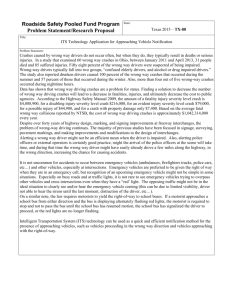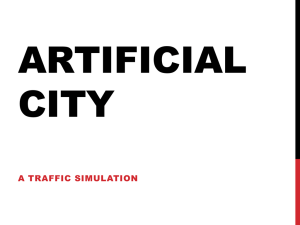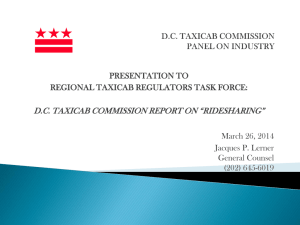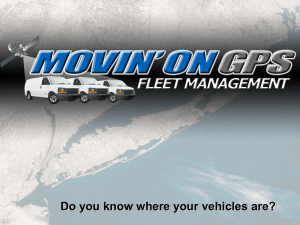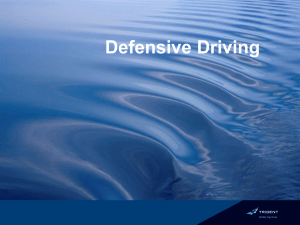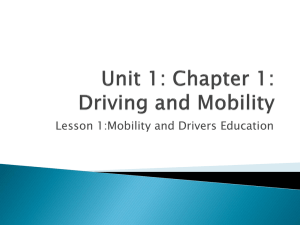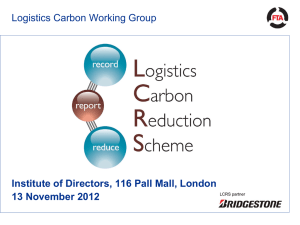Heather Ward
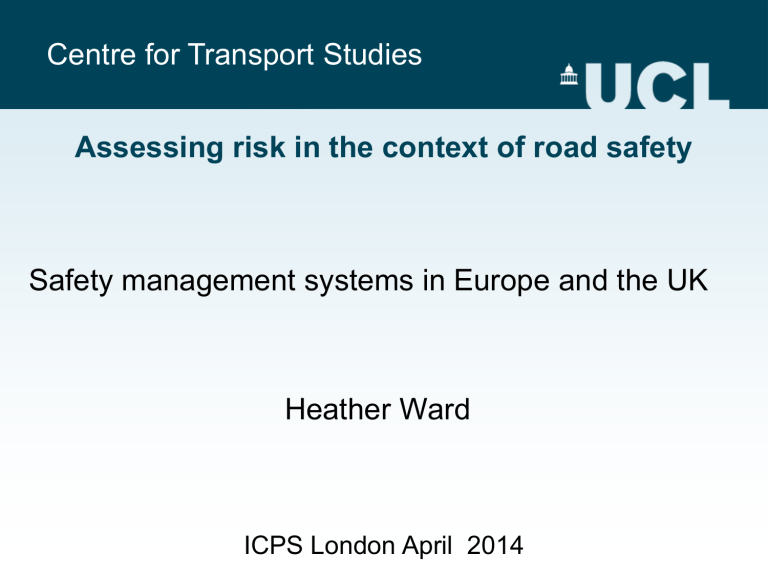
Centre for Transport Studies
Assessing risk in the context of road safety
Safety management systems in Europe and the UK
Heather Ward
ICPS London April 2014
Centre for Transport Studies
Risk of death and serious injury on the roads of the world
• 1.24 million killed on the roads each year
• 20-50 million sustain non-fatal injuries
• Young adults between 15 and
44 years account for 59% of global road traffic deaths
Centre for Transport Studies
Factors leading to collisions
• Fatigue - sleepiness
• Drink and drugs
• Foreign drivers
• Overloaded or poorly maintained vehicles
• Illegal speeding and other violations
• Mobile phones and other distractions
• Road related features
Centre for Transport Studies
Governments pass legislation to regulate conduct of drivers - important to reduce risk factors leading to road deaths and injuries
• speed limits,
• safety-belts and child-restraint laws,
• helmet laws,
• blood-alcohol concentration limits,
• daytime running light requirements,
• mobile phone laws, and
• licensing regulations.
Centre for Transport Studies
Centre for Transport Studies
European Regulations governing working goods vehicles over 3.5 tonnes, buses over 8 seats, and coaches over 15 seats
• Size and weight of goods vehicles
• Drivers’ hours of working
• Maximum speed of goods vehicles
• Mirrors, side and rear under-run protection
Centre for Transport Studies
EU permitted length, weight and height length weight height
Buses and coaches
12m rigid
18m articulated
4.57m
Rigid hgv 12m
Articulated hgv
16.5m
18m with trailer
18.5m road train
18 tonne
40 tonne
44 tonne if road friendly suspension n/a n/a
Centre for Transport Studies
Maximum driving time to address fatigue
• 9 hours in a day - this can be extended to 10 hours twice a week
• 56 hours in a week
• 90 hours in any 2 consecutive weeks
Centre for Transport Studies
Top speed is limited
National speed limits for vehicle type and weight apply when lower than the top speed which limiter controls. Tachographs give speed driven.
– Bus - 100 km/h
– Coach – 122 km/h (in UK 100km/h)
– HGV over 3.5 tonne 90 km/h
Centre for Transport Studies
Some safety features on HGVs
• Nearside turning vehicles dangerous for cyclists and pedestrians as can get caught in blind spot.
Mirrors are required
• Under-run protection helps stop cyclists and pedestrians being dragged under the wheels. Solid
‘skirts’ are best but side and rear protection required
Centre for Transport Studies
Each country responsible for enforcement of
EU regulations on their own roads
• Each vehicle must be fitted with a tachograph to automatically record speed, distance, driving time and rest time
• All UK and European drivers on UK roads legally required to record their activities and produce them on demand to police or DVSA
• Operators/employers must download weekly record from each driver and keep for one year
Centre for Transport Studies
Driver and Vehicle Services
Agency and Police
• Check authorised load weights and type of load permitted
• Check vehicles (lorries, buses and coaches) for roadworthiness and mechanical faults
• DVSA conducts statutory testing and issues certificates
• Look at tachograph records
• Make sure driver has a valid occupational driving licence
• Issue penalty notices and impound vehicles
Centre for Transport Studies
Safety management systems for occupational road risk in the UK
• The casualty problem
• Legislation, regulation and enforcement
• Driver responsibilities
• Operator/company responsibilities
• ISO39001 and safety management
Centre for Transport Studies
Road users killed or injured by an at-work driver/rider
Centre for Transport Studies
The casualty situation
Commercial vehicles involved in about 19% of fatal collisions in 2013
This is a big issue which has been difficult to resolve
Vehicle type
Bus and coach
2
6 Light van
HGV
>3.5 t
11
Percent of total
Rate per billion veh km
26
4.1
10
Centre for Transport Studies
Who is responsible for work related road safety?
• The European Union through vehicle and driver driving time standards
• Department for Transport for road safety policy and statistics
• The Police and the Driver and Vehicle Standards
Agency (DVSA) for enforcement and compliance
• The Health and Safety Executive for work place safety and risk
Centre for Transport Studies
Europe and UK do not regulate cars and light vans used for work
• The EU regulates commercial vehicles but the employer still has responsibility for managing their risks
• A company where cars and/or light vans are used for work needs a good road safety management structure with a written policy and clear lines of management responsibility
• The Health and Safety Executive is responsible for workplace safety
Centre for Transport Studies
Health and Safety legislation
• The Health and Safety at Work Act requires employers to ensure the safety of their employees whilst at work and ensure members of the public are not put at risk by work related driving activities
• Management of Health and Safety at Work
Regulations requires employers to assess and manage risks to employees and others.
Centre for Transport Studies
Some reasons given by companies for not managing work related road safety (
Source Driving for Better Business)
• My drivers know how to handle their vehicles
• Everyone has passed a driving test
• Everyone has a driving license before we let them drive
• I can’t influence the behaviour of people when they drive
• Driving isn’t anything to do with health and safety
• Driver training will fix the problem
• My insurance covers the costs so why worry
• Some Road Traffic Collisions are inevitable and there is nothing I can do about that.
Centre for Transport Studies
Driving for Better Business
• Government recognised need to give higher priority to work related road safety especially for cars and vans
• Need a systematic programme which encouraged
Health and Safety practices applied to driving at work
• A document was published by health and Safety
Executive on managing work related road safety http://www.hse.gov.uk/pubns/indg382.htm
Centre for Transport Studies
Managing work related road safety has many benefits
• Fewer days lost due to injury;
• Reduced risk of work-related ill health;
• Reduced stress and improved morale;
• Fewer incidents mean less need for investigation and paperwork;
• Less lost time due to work rescheduling;
• Fewer vehicles off the road for repair;
• Reduced running costs through better driving standards;
• Fewer missed orders and business opportunities so reduced risk of losing the goodwill of customers.
Centre for Transport Studies
Driving for Better Business – 10 essential elements for Companies
1. Assign a senior manager
2. Incorporate Health and
Safety policy to driving
3. Do risk assessments and act on results
4. Properly record every incident and analyse to prevent recurrence
5. Written guidance for drivers
6. Vet drivers to ensure fit, licenced competent and well trained
7. Ensure vehicles suitable for purpose
8. Ensure vehicles regularly inspected and maintained
9. Is journey necessary by car/van large HGV
10. Is journey time realistic re speed and rest breaks
Centre for Transport Studies
Centre for Transport Studies
Centre for Transport Studies
Centre for Transport Studies
The tendering process for good and services
• Can through the process of tendering for services require suppliers to demonstrate they have safety management systems in place
• An example is Crossrail in London which is building a new railway from west to east London
• Has extensive contract requirements including for vehicle equipment and driver training to enhance safety
Centre for Transport Studies
Centre for Transport Studies
ISO 39001 RTS management system needs procedures and processes to built in to the company management system
• Leadership and commitment to safety from management
• Written policies communicated and understood throughout company with systems in place to regularly review and update
• Clear structure for responsibility and authority for safety in company
• A set of realistic performance indicators which can be measured
• Evaluate the risks so can ensure staff well trained and understand context in which they are operating
• Create a safety culture in the organisation e.g. drink, drugs, fatigue, competence, which is continually monitored and updated and in which everyone is involved
• Legal compliance
Centre for Transport Studies
Thank you
h.ward@ucl.ac.uk


